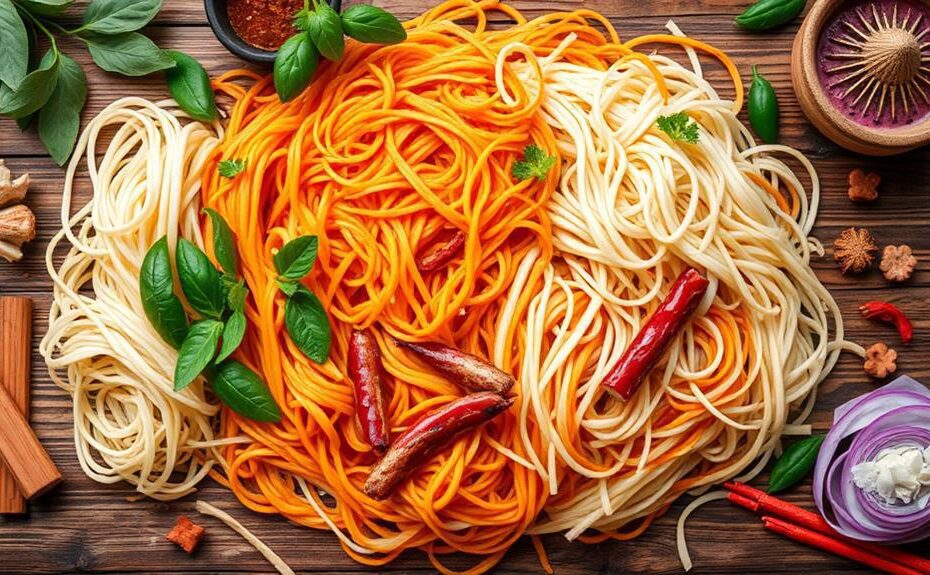You can choose from various types of Pancit rice noodles, each with distinct characteristics and cooking requirements.
Bihon noodles are thin and absorb flavors well, making them a great option for dishes where you want the noodles to take on the flavors of the sauce or seasonings.
Canton noodles, on the other hand, offer a chewier texture that pairs well with heartier ingredients.
For a more unique mouthfeel, Lomi and Miki noodles are great options. They provide a distinct texture that works well in dishes with bold flavors and ingredients.
Misua noodles are another option that enhance flavors without overpowering, making them a great choice for delicate ingredients.
Sotanghon noodles, made from mung bean starch, offer a transparent and unique texture that adds visual appeal to any dish.
With so many types of Pancit noodles to choose from, you can select the one that best suits your desired flavor, texture, and cultural significance.
Types of Pancit Rice Noodles
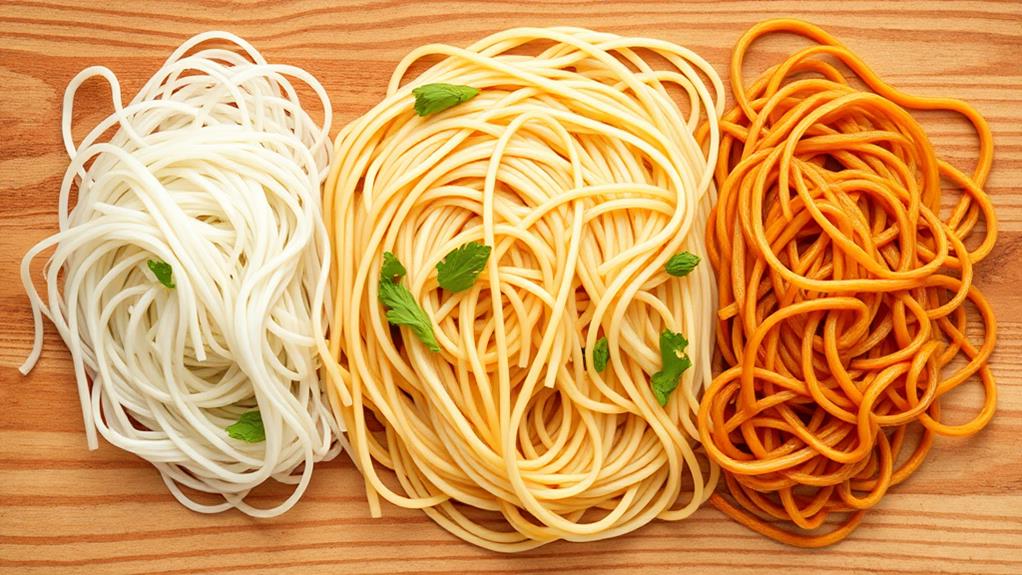
The type of rice noodle used in Pancit significantly affects the dish's flavor and texture.
Pancit Bihon uses thin rice noodles made from cornstarch and rice flour, which are ideal for absorbing flavors from sauces and broths.
These bihon noodles are also versatile and can be easily sautéed, making them perfect for traditional stir-fried dishes like Pancit Bihon.
Misua, another type of rice noodle, is extremely thin and typically served in soups, enhancing the dish's flavor and texture.
For a heartier option, Pancit Malabon utilizes thick rice noodles, often paired with seafood and a rich sauce.
Other variations, such as Lomi and Miki, incorporate different styles of noodles for unique culinary experiences.
Bihon Noodles Characteristics
Bihon Noodles Characteristics
Bihon noodles are a staple in Filipino cuisine, known for their versatility in various dishes, including traditional stir-fry recipes like Pancit Bihon.
Texture
Bihon noodles have a light and delicate texture, which allows them to easily absorb flavors from sauces and broths. This texture is due to their composition of primarily cornstarch and rice flour.
Versatility
Bihon noodles are highly versatile, making them suitable for a range of dishes, including stir-fries, soups, and more. This versatility has made them a staple in Filipino cuisine, often featured in traditional recipes like Pancit Bihon.
Flavor Absorption
Bihon noodles easily absorb flavors from sauces and broths, enhancing the overall taste of the dish. This characteristic makes them an ideal choice for dishes where flavor absorption is crucial.
Preparation
To prepare bihon noodles, they're typically soaked in warm water for 8-10 minutes, softening them for stir-frying. This preparation method helps to rehydrate the noodles, making them ready for cooking.
Cultural Significance
In Filipino culture, bihon noodles are often served during celebrations and family gatherings, symbolizing good fortune and longevity. This cultural significance highlights the importance of bihon noodles in traditional Filipino cuisine.
Canton Noodles Vs Bihon Noodles
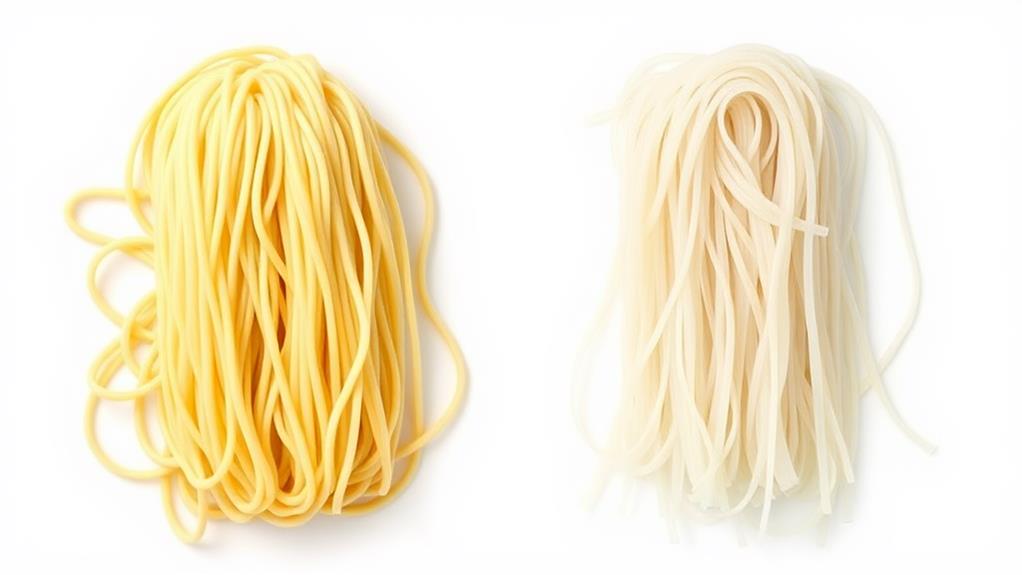
Canton noodles and bihon noodles are two popular varieties of pancit rice noodles that differ in composition, texture, and flavor profile.
Composition determines the noodle's core characteristics. Canton noodles are made from wheat flour and egg, while bihon noodles are made from rice flour and cornstarch.
Texture is a key distinguishing factor. Bihon noodles have a lighter, more delicate texture, whereas Canton noodles are chewier and sturdier.
Cooking methods vary between the two noodles. Bihon noodles require soaking in warm water to soften, while Canton noodles can be boiled if needed before stir-frying with vegetables.
Flavor profiles also differ. Bihon noodles absorb sauces and broths well, enhancing the overall taste of dishes, while Canton noodles provide a heavier base for savory flavors.
Both Canton and bihon noodles are staples in Filipino cuisine, often used in various pancit dishes.
Understanding their unique characteristics allows you to choose the right type of noodle to suit your culinary preferences and create delicious, authentic Filipino meals.
Lomi Noodles for Hearty Dishes
Lomi noodles are a staple in Filipino cuisine, particularly in hearty dishes. They owe their distinct yellow hue and springy texture to their production process involving lye water. This process enables them to hold up well in rich, saucy preparations.
Their thick and chewy texture makes them an excellent choice for absorbing flavors. In Pancit Lomi, lomi noodles effectively absorb flavors from the broth and sauces, enhancing the overall taste of the dish.
Their substantial mouthfeel provides a more filling meal compared to thinner noodles like bihon.
Lomi noodles retain their shape and texture when cooked, making them versatile for various noodle dishes. Beyond traditional Pancit Lomi, they can be used in a range of hearty dishes that require noodles that can hold their own.
Their ability to absorb flavors and retain shape makes them an ideal choice for satisfying and flavorful meals.
Miki Noodles for Versatile Recipes
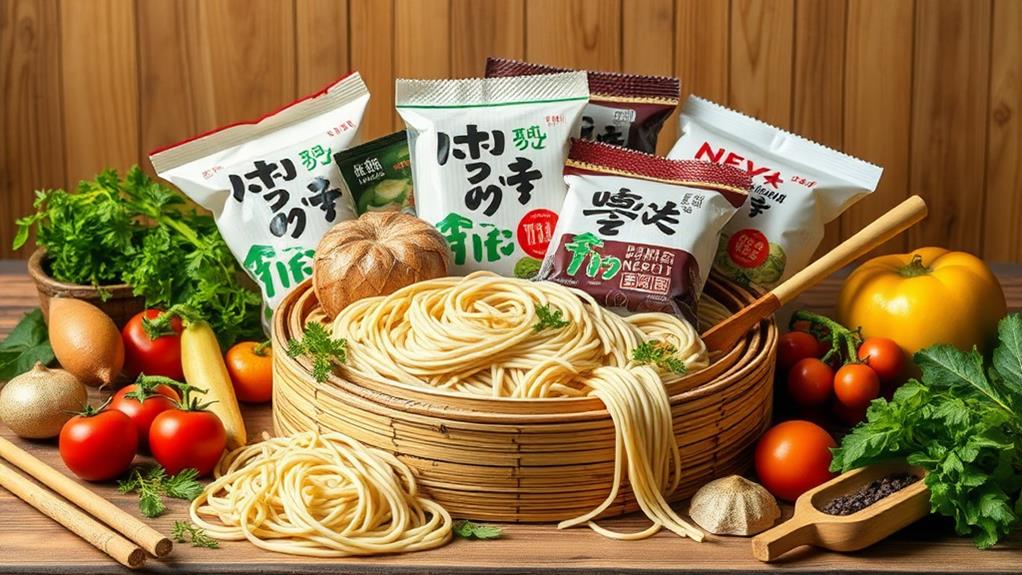
Miki Noodles: A Versatile Ingredient in Filipino Cuisine
Miki noodles are one of the three dominant types of noodles in Filipino cuisine, known for their chewy texture and versatility in various dishes. They're made from all-purpose flour and available in flat and round shapes, making them suitable for various recipes.
Culinary Applications
Miki noodles are ideal for:
- Stir-fries, where they quickly absorb flavors
- Soups, where they hold their texture despite the liquid
- Noodle salads, where they add a delightful chew
- Traditional Filipino recipes, like Pancit Miki, where they enhance the dish's heartiness and texture
Cooking with Miki Noodles
When cooking with miki noodles, they hold up well in flavorful broths and sauces, absorbing rich flavors during cooking.
Since they're typically sold fresh, salted, and partially cooked, preparation is quick and easy. This makes them an excellent choice for their durability and adaptability in both classic Filipino dishes and new recipes.
Misua Noodles for Soups and Stir-Fries
Misua Noodles: A Perfect Fit for Soups and Stir-Fries
Misua noodles, made from wheat flour, are extremely thin and salted, making them an ideal choice for soups and stir-fries. Their unique characteristics enhance the flavor and texture of dishes, and they cook quickly, usually in just a few minutes.
Characteristics and Benefits
Misua noodles are extremely thin, allowing them to absorb flavors effectively.
They're salted, which enhances flavor and texture in traditional Filipino dishes.
Their lightweight nature makes them a great addition to stir-fries with vegetables and proteins, offering a unique twist to typical noodle dishes.
Finally, they cook quickly, making them a convenient option for fast meals.
Traditional Uses and Applications
Misua noodles are often featured in traditional Filipino dishes like almongdigas, where their delicate texture complements savory broths.
They can also be stir-fried with vegetables and proteins, maintaining their delicate structure while adding a new dimension to the dish.
Sotanghon Noodles for Unique Textures
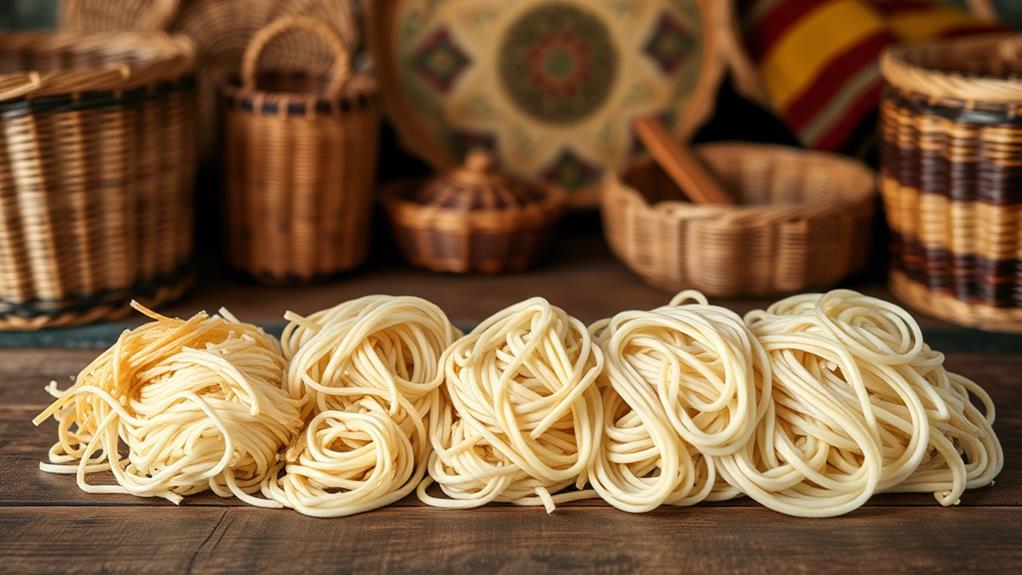
Sotanghon Noodles Offer Unique Textures and Versatility
Filipino cooks often turn to Sotanghon noodles to add a distinct texture to their dishes. These noodles, made from mung bean starch and water, have a transparent appearance when cooked and a slightly chewy texture that absorbs flavors well, making them ideal for soups and stir-fries.
Benefits of Using Sotanghon Noodles
Adding a Twist to Traditional Recipes: Sotanghon noodles can be used to create unique variations of traditional pancit recipes, such as Pancit Sotanghon or Chicken Sotanghon Soup.
Preparation Enhances Texture: Unlike rice or wheat noodles, Sotanghon requires soaking in warm water for a short period before cooking, which enhances their texture.
Nutritional Benefits: Sotanghon noodles are rich in carbohydrates and low in calories, making them a popular choice for those seeking a lighter noodle option in their meals.
Flavor Absorption: Sotanghon noodles can absorb flavors well, making them a great addition to your favorite soups and stir-fries.
Choosing the Right Noodle Type
Choosing the Right Noodle Type
When it comes to pancit rice noodles, there are various options to consider, each with its own unique characteristics and uses.
To select the ideal noodle type, consider the texture, flavor, and cooking time you desire.
Understanding Noodle Types
Different noodle types offer distinct characteristics that cater to specific needs.
Pancit Bihon, for instance, is known for its thin rice noodles that are versatile and absorb flavors well.
Canton Noodles, on the other hand, have a chewy texture due to being made from wheat flour and eggs, making them ideal for stir-fry.
If you prefer a heartier option, Pancit Lomi offers wide, thick egg noodles with a unique flavor profile.
For a more delicate option, Misua/Miki Noodles are extremely thin salted wheat noodles with a delicate texture and quick cooking time.
Cooking and Preparation Techniques
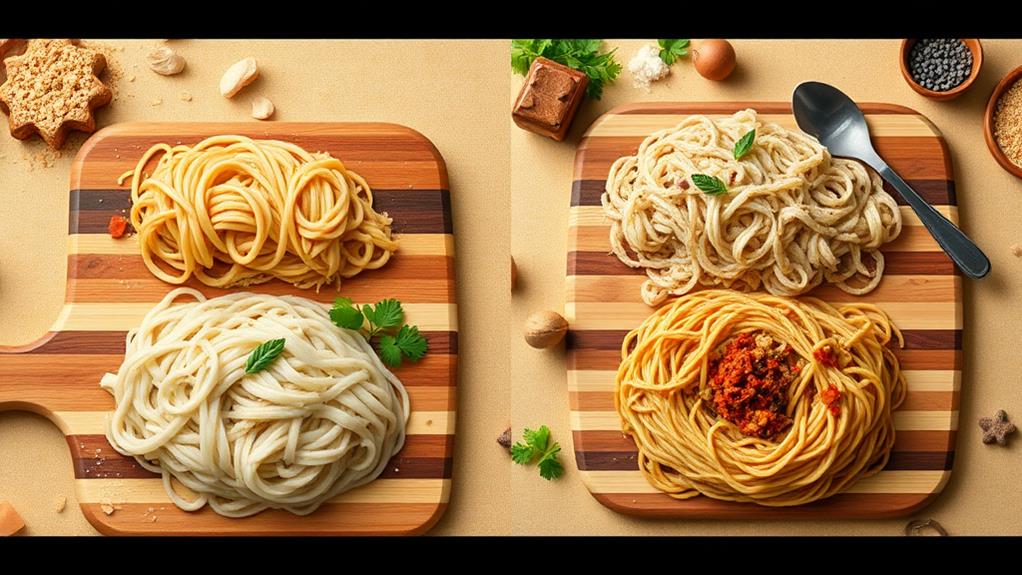
When cooking with pancit rice noodles, specific techniques are necessary to bring out their unique characteristics.
Soaking is essential for bihon noodles. Soak them in warm water for 8-10 minutes until softened, allowing them to absorb flavors from the dish during cooking.
Miki noodles require preparation. Soak them in water until they become pliable, making them ideal for stir-frying with various ingredients.
Canton noodles need stir-frying. Stir-fry them with proteins and vegetables to achieve a chewy texture that holds well in savory dishes.
Misua noodles require quick cooking. Cook them in broth for soups, enhancing the dish's flavor without becoming mushy.
Can I Use Different Types of Pancit Rice Noodles for Different Cooking Methods?
Yes, you can use different types of pancit rice noodles for different cooking methods. Thinner noodles are best for stir-frying, while thicker noodles work well in soups. The best way to cook pancit noodles depends on the dish you are making, so choose the appropriate noodle for your desired cooking method.
Noodle Pairing and Serving Suggestions
Choosing the Right Noodle for Your Pancit Dish
When selecting a noodle type for your pancit dish, consider the unique characteristics of each to create harmonious pairings and serving suggestions.
Bihon noodles are ideal for lighter pancit dishes, as they absorb flavors well and provide a subtle texture. In contrast, Canton noodles are perfect for stir-fried pancit, maintaining their chewy bite even under high heat.
Selecting Noodles for Heavier or Lighter Textures
For a heartier texture, lomi noodles are the best choice, especially for saucy versions like Pancit Lomi.
Miki noodles offer versatility, suitable for both stir-fried and broth-based preparations. When creating rich soups or brothy pancit dishes, misua's thinness enhances the meal without overwhelming other flavors.
Frequently Asked Questions
What Kind of Noodles Are Used in Pancit?
Bihon noodles are traditionally used in pancit. Made from rice flour, cornstarch, and water, these thin noodles absorb flavors well, making them perfect for various pancit dishes.
Their versatility allows for a range of flavors to be absorbed.
Other pancit noodle varieties can also be used, such as Canton, Lomi, or Misua, each offering unique textures and flavors.
Is Vermicelli the Same as Pancit?
Vermicelli and pancit aren't interchangeable terms. While both refer to thin rice noodle varieties, they've distinct meanings.
Vermicelli is a general term for a type of noodle, whereas pancit is a specific type of noodle dish originating from Filipino cuisine. Pancit encompasses a broader category of noodle dishes, rooted in traditional recipes, cultural significance, and regional differences.
Pancit noodles have a lighter texture, achieved through specific cooking methods, which allows for a more delicate flavor profile.
This makes pancit a staple in many Filipino households.
Can You Use Ramen Noodles for Pancit?
Ramen noodles can be used as a substitute for traditional rice noodles in pancit, but it's essential to adjust cooking times and techniques.
Ramen noodles have a distinct chewy texture, which may affect the dish's flavor profile. Unlike traditional rice noodles, ramen noodles mightn't absorb flavors as well, resulting in a different taste experience.
To make it work, adjust cooking times to prevent overcooking, as ramen noodles can become mushy if cooked for too long.
For a more authentic pancit experience, traditional rice noodles are recommended. They offer a better texture and flavor compatibility with the sauce and other ingredients.
Are All Rice Noodles the Same?
Not all rice noodles are the same. Different varieties of rice noodles exist, each with its own traditional ingredients and cooking techniques. For example, rice noodles from Japan, called "soba," are made from buckwheat flour and have a nutty flavor.
In contrast, rice noodles from Southeast Asia, like "pho" noodles, are made from rice flour and water.
Regional differences also affect the flavor profiles and textures of rice noodles.
Some rice noodles are designed for specific dietary considerations, such as gluten-free or vegan options. Others offer unique health benefits, like high fiber content or lower calorie counts.
When choosing a rice noodle, it's essential to consider these factors to ensure the best serving suggestions for your dish.
